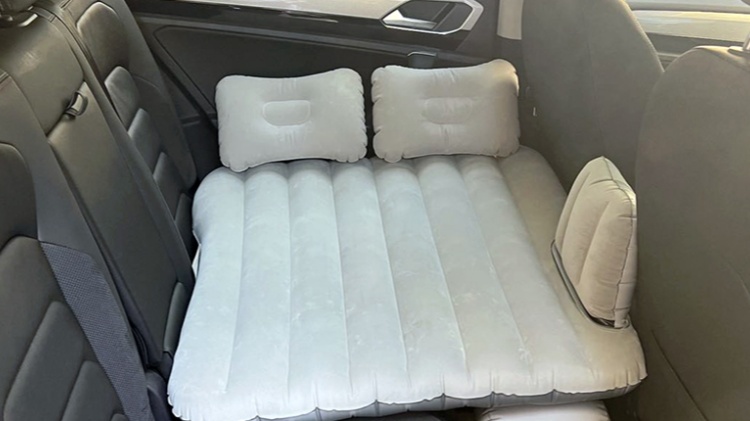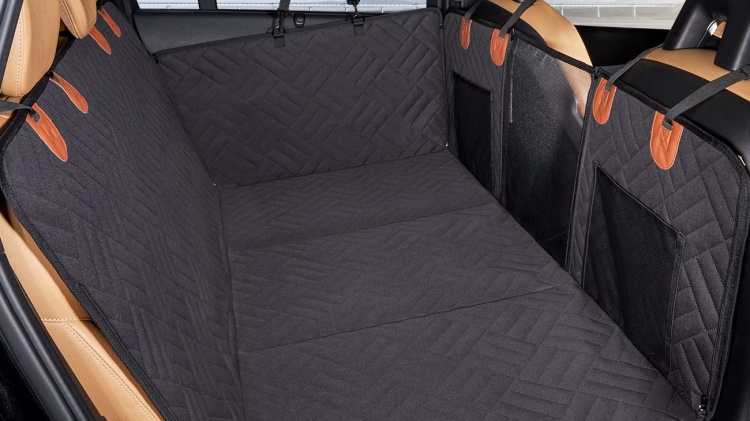
Leicht zu reinigen: Tipps zur Pflege und Aufbewahrung Ihrer Auto-Luftmatratze
A car air mattress is a handy accessory that can transform your back seat into a bed on the go. But like any gear, it

One of the best modern conveniences for car camping and road trips is the invention of the back seat air mattress. With just a bit of inflation, these portable beds turn the cramped car back seats into a cozy sleeping space or lounge area.
But with limited room to work with, choosing the right level of thickness and inflation is key.
A mattress that overfills the space can force you into awkward positions all night, which leads to discomfort and wrist pain. But too thin will leave your body sinking onto the hard floor pan. Finding the Goldilocks thickness maximizes comfort when dealing with the confined quarters of most car interiors.
In this blog, we’ll cover tips on choosing the ideal thickness and inflation level for your backseat air mattress based on passenger space and comfort needs. Learn how to find that sweet spot for sleeping in a small space sleeping!

We spend about a third of our lives sleeping, so maximizing comfort for a good night’s rest is essential, even in a car. Mattress thickness affects comfort in these key ways:
Cushioning for pressure points: A thicker, more inflated mattress provides conforming cushioning support for pressure points like the shoulders, hips, knees and elbows. This contouring aligns the spine and prevents pain.
Insulation from hard surfaces: A more inflated thickness prevents you from bottoming out on the hard plastic or metal floor pan and puts space between your body and the cold/hot car interior surfaces.
Spinal alignment: The right thickness keeps your spine neutrally aligned in its natural position rather than forcing it to sag without adequate padding and support underneath.
Air mattress shape integrity: A fully filled mattress maintains its internal structure and chambers rather than unevenly compressing down into the space. The right inflation prevents back seat contours from misshaping the mattress.
Getting the thickness just right has a big impact on how content and pain-free you’ll be as you log miles down the highway or snooze under the stars. Under-inflation can lead to tossing, turning and waking up with aches and pains – which defeats the purpose of a mattress upgrade.
Consider these factors as you evaluate your needed thickness and choose an air mattress model:
Your particular car model is: Make sure to get accurate measurements of the length, width and height of the back seat area you plan to inflate the mattress in. This ensures a proper fit.
Number of passengers: Will the mattress need to accommodate one adult sleeper or two people? Are you also using it for kids? The needed thickness and weight capacity increase with more occupants.
Vehicle type: Trucks, minivans, and SUVs allow more vertical thickness when inflated versus low-sitting sedans. Measure the vertical space your seats allow when folded down.
Seat folding configuration: Can your back seats fold fully flat, or is there an angle or gap between the seat back and cushion? Fitting the mattress thickness to the contours prevents uncomfortable bending.
Doing some measurements for your specific make and model ensures you get the maximum thickness your particular backseat setup allows before buying.

As a general rule of thumb for back seat mattress thickness when inflated:
The limited room of small economy cars works best with an air mattress thickness in the 4 to 6-inch range when fully inflated. This provides basic cushioning without over-crowding the cramped space.
Most standard midsize sedans and crossovers have a bit more interior cabin height to accommodate 5-7 inches of thickness when inflated. This gives medium cushioning, great for one adult or two small kids.
For pickups, full-size SUVs, and vans with very expansive cargo space, aim for an inflation thickness between 6 and 8 inches. The extra room allows multiple sleepers to have enough support and insulation.
More convenient self-inflating open-cell foam mattresses tend to fall in the 3-5 inch thickness range. The dense foam still provides conforming comfort and support in more limited spaces.
No matter your vehicle type, make sure you have at least 3 inches of inflation for basic padding. Get as thick as the space safely allows.
Start on the lower end of the recommended thickness range for your type of vehicle and fine-tune the firmness to your individual preference:
Lie down in a few different areas of the mattress and make incremental adjustments until you find the “just right” amount of thickness. The mattress should provide full body support without crowding you into the ceiling or compartment lid when closed.
Focus on adding inflation until the gaps between the mattress and car interior edges are minimized. This prevents you from sagging down into uncomfortable depressions during the night. Even 1-2 inches can make a difference in comfort.
Do you need more or less thickness and inflation in certain areas based on your body size and shape? You can place rolled towels or blankets to add regional micro-adjustments.
Do you shift positions frequently or stay stationary all night? Side sleepers often need a thicker surface to cushion shoulder and hip pressure points. Adjust based on your tendencies.

Follow these tips every time to get the best night’s sleep possible in your portable back seat bed away from home:
A bit of initial trial and error helps you learn what settings, accessories, and positions allow you to sleep soundly and wake up refreshed, even while crammed into a car. Sweet dreams!
Still, struggling with nagging discomfort or support problems on your back seat mattress? Try these tips:
With some fine-tuning adjustments, you can dial in the perfect firmness and thickness for drifting off into dreamland, even in the most cramped spaces. Follow these tips to enhance comfort on your next car camping trip or road trip. Sweet dreams!


A car air mattress is a handy accessory that can transform your back seat into a bed on the go. But like any gear, it

A back seat air mattress is a convenient way to convert your car into a cozy sleeping space for road trips and camping. But special

A back seat air mattress is a great way to transform your car into a comfortable sleeping space. Whether you’re going on a road trip

A back seat air mattress is one of the handiest accessories for car camping and road trips. With quick inflation, you can transform your vehicle’s

A car air mattress is a handy accessory that can transform your back seat into a bed on the go. But like any gear, it

One of the best modern conveniences for car camping and road trips is the invention of the back seat air mattress. With just a bit

A back seat air mattress is a convenient way to convert your car into a cozy sleeping space for road trips and camping. But special

A back seat air mattress is a great way to transform your car into a comfortable sleeping space. Whether you’re going on a road trip
Copyright © 2024 backseatairmattress. All Rights Reserved.